I have a confession to make…I’ve never played Dungeons and Dragons. I’ve always been interested but frankly, I wouldn’t know where to start now. I can only imagine how many books are out there and how long it would take for me to get up to speed on how the whole thing works. I’ve heard that it can take hours just to create a character…perhaps if I were twenty years younger and didn’t have a full-time job as both an accountant and a parent *shrug*. Luckily, I found this little gem, which takes place in the port city of Waterdeep from the D&D realm. Sure, there aren’t any D20 initiative rolls (my apologies if I butchered that), but the game still has “Dungeons and Dragons” printed on the box. At this day and age, I’ll take whatever I can get…assuming it takes less than two hours to play. As it turns out, I couldn’t be more than pleased with my purchase.
By now, somewhere, in some mother’s basement, someone’s glasses are fogging up. Yes, I’m well aware that Lords of Waterdeep is not really a true, old school D&D game and that the setting is probably the only factor that relates. Lords of Waterdeep is a worker placement game to where the final goal is to score the most victory points. Those who have played Agricola, Stone Age, or Caylus (just to name a few) would probably feel right at home with this game.
To sum up this particular game, players will be recruiting various adventurers (fighters, clerics, rogues, and wizards) to complete quests. These quests are the main way to quickly move up the victory point track, though you’ll be able to compliment your score through other means. Let me take a moment to explain the components and then I’ll touch briefly on the rules before going into the review.
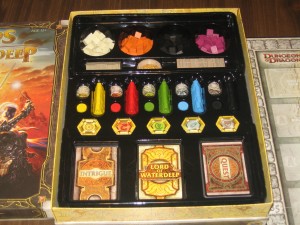
In case I don’t mention this again, the tray insert is fantastic. The design allows players to easily get pieces out of the box while making cleanup fast and easy.
Components
Agents – Players will be given so many agents (workers) depending on how many people are playing the game. Agents will be assigned by players on their turn to recruit adventurers, accept quests, play or draw intrigue cards, purchase buildings, and etc.
Score Markers – Players will be using these solid colored tokens to move along the victory point track that borders the outside of the board. Each colored token has an accompanying “100″ victory point token that is given to players in the event that they score higher than 100 during the game.
Adventurers – Adventurers are represented by colored cubes. White = Cleric, Orange = Fighter, Black = Rogue, and Purple = Wizard. These adventures will be recruited and later “traded in” to complete quests.
Buildings and Building Control Markers – Throughout the game, buildings will be available to be purchased by players. These buildings allow agents (from any player) to perform particular actions. Control markers are color coded and placed into the building’s groove so that players can keep track of who owns what buildings. The owners of these buildings often collect a bonus every time someone else “shops” there.
Gold – Gold is used for purchasing buildings and completing certain quests. The square tokens are worth one gold and the crescent-shaped tokens are worth five.
Victory Point Tokens – These tokens look like red jewels and are placed on the round counter / track on the playing board. At the beginning of every round, the three VP tokens on the next round space are placed on the three available buildings that can be purchased, one for each. This is to help make a particularly unpopular building look a bit more appetizing in terms of being purchased. Buying a building with VP tokens on them allows the player, you guessed it, to move their score marker along the track.
Lord Cards – Before the game begins, one lord card is randomly dealt to each player. The identity of the “lord” is kept secret. These cards describe bonuses that are awarded to players at the end of the game should they satisfy certain conditions. For example, one lord rewards VP at the game’s end for every building the player built.
Intrigue Cards – Intrigue cards serve as a way for players to mix things up from the monotony of recruiting adventurers and completing quests. Some intrigue cards serve as an attack in order to set your opponent(s) back or they could be used to bolster your own forces. They can only be played at a particular location (the harbor), though players who assign their agent there can move them elsewhere once everyone’s agent pools are exhausted.
Player Mats – Each player will have a player mat of their color to help them organize their possessions. Each color has a guild / faction named after it, however there aren’t any differences between them other than for artistic purposes.

The production values of the pieces and cards are fantastic as well. The sharp / detailed art is the first thing I’m drawn to when I draw a quest card.
Game Setup
Each player receives a particular number of agents, a player mat, a score marker which is placed on “0″, a lord card face down, two quest cards face up, two intrigue cards face down, and a certain amount of gold depending on which player starts first.
The quest, intrigue, and building decks are placed on their appropriate places on the board. Three VP tokens go on each space of the rounds track. An extra player agent of each color is placed by the ”round 5″ track, which players can take once that point is reached in the game. Three buildings are drawn and the round one VP tokens are placed on them. Four quest cards are placed face up at the inn.
Gameplay & Mechanics
Players take turns assigning agents, one at a time, to various spaces on the board. These spaces could be the default buildings that are built into the board or new buildings that may have been built by other players. Players can also complete a quest after placing an agent, should they wish. Spaces are limited to one agent per space by default, but certain special circumstances allow players to double up on a space.
Quests come in various shapes and flavors…complete with their own category at the top of the card that allows players to identify what kind of quest the card is. Warfare quests often require a lot of orange fighter cubes, just as an example. These quest types play a part in bonuses that some of the lord cards provide. Just as an example, one lord card might reward so many victory points at the end of the game for every commerce or piety quest you completed. Quests often reward you with gold, adventurers, intrigue cards, victory points…just to name a few, but some (called plot quests) remain in your play area after being completed and provide you with a permanent bonus.
Once all agents are assigned, players take the agents back and a new round begins. This consists of adding quest / building cards to any empty inn / builder’s hall spaces that may have been claimed in the previous round. Three more VP tokens from the round track are then distributed among the buildings.
After the final around, players receive 1 VP for each adventurer in their tavern + 1 VP for every two gold they have + VPs for their lord card bonus and adjust their score marker accordingly. The person with the most VPs wins.
There’s a bit more to it than that, but the above should give you a rough idea on how the game is played and whether or not it’s something you’d be interested in.
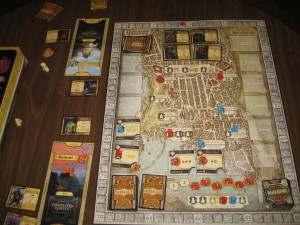
The plot quest I completed gave me bonus victory points for every Arcana quest I completed in the future.
The Review
I have to say, the components are top-notch. Everything from the pieces, to the art, to the plastic tray insert is fantastic. I can’t stress this enough. Even the manual is excellent as it includes appendices for all of the buildings, lord cards, and etc while also including a picture of how the pieces fit into the game’s plastic insert. I’d give a thumbs up to this game just for this particular aspect alone.
This game is fairly simple to learn and play. The most complex part, at least in my opinion, was getting used to all of the options you may have at any one time. There are many buildings that do various things…it’s often that you may need to pause to figure out how you want to go about getting the resources you need while preventing your opponent from getting the resources they may need. Sure, you could assign an agent to your opponent’s shop to get that fighter and wizard you need…but as a reward for you shopping there, your opponent may get the fighter they need to complete a quest.
I really like the addition of the lord cards as they allow players to specialize in certain areas. For example, my son had the lord card that provided him with a bonus for every building he built by game’s end. I, of course, didn’t know that, though I noticed him purchasing buildings like mad throughout the game. I chalked it up to him just liking the feeling of owning a building…I won’t make that mistake again. I was winning, but he pulled ahead and won by a hair because of all the bonus points he accumulated at the end of the game.
My son’s favorite part of the game was completing quests…he enjoyed figuring out what he needed and where to go to get them. The scores were close all the way through so neither of us felt like we were beaten before the game came to its conclusion. My favorite part was purchasing buildings…rewarding the owner of the building with resources or points is an excellent game mechanic in my opinion.
If you’re a fan of worker placement games, then I highly recommend Lords of Waterdeep.
Final Verdict: 9/10
—

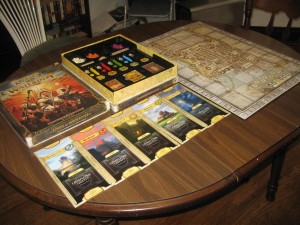
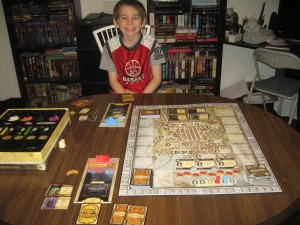
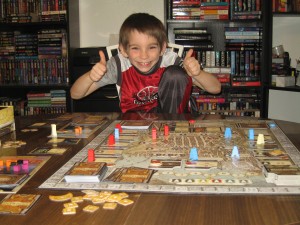
How old was your son when this was played? I’m trying to figure out if my kids can play it and have fun. I think box says 12+ but your son doesn’t look 12 to me.
Hi Jerry,
The article was published May 2012 and his birthday was in April, so he had just turned 12 at that point. It helps to have an experienced adult gamer in the family, helping to keep the kids on task and reminding them of the rules. Every family is different in that regard, so I suppose my question is, how often do you or the kids play board games, and are they complex? There is a learning curve, but once you get a few games under your belt it’s fairly easy to play, especially if you are an experienced gamer already.